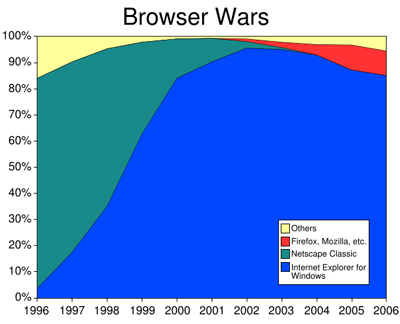1.2.3. Technique
Before starting with the realisation of the application, some technical aspects have to be defined:
- Storage of data (Database, XML, Storage of Attributes in Geometry)
- If Storage of data in a database: Query technique
- Visualisation (
 Flash,
Flash,  SVG, etc.)
SVG, etc.) - Technique for Interaction (
 JavaScript,
JavaScript,
 ActionScript, etc.)
ActionScript, etc.)
It is important to specify where to store the data. Depending on the storage type we have to define how (with which scripting language) to extract the data for our application.
We recommend you to store the thematic and the geometric data seperately for bigger projects, e.g. storing the thematic data in a database and the geometric data in a SVG file, etc. You will learn more about the advantages of this storage method in the next lesson Internet Techniques and Web Formats.
|
The choice for the interaction technique depends on the visualisation technique: When using SVG you have to program the interaction parts with JavaScript; when using Flash the interaction parts have to be programmed in ActionScript; etc. |
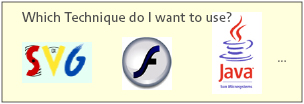 Examples of Techniques Examples of Techniques |
We do not want to give you any recommendation for a specific format that
has to be used for multimedia applications. The choice depends on various
factors such as the existing knowledge of the developer, the available hardware
and software of the future users, etc.
Software and Hardware Problems
There are some aspects that have to be considered when coming to a decision about the technique that will be used. The ignoring of these aspects may cause some problems on the user side:
Hardware Problems
- Screensize:
The applications are always displayed on the screen. The display size varies from user to user. Some possess a 21 inch display which is pretty wide and some possess only a 15 inch screen. Whether the screen is wide or not, always the whole application has to be displayed on it. That means that e.g. the font size has a different appearance on a 21 inch screen than on a 15 inch screen.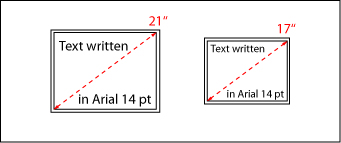 Font on different displays
Font on different displays
Considering Web Maps: Although the size of the displays may vary, it is more or less fix in contrast to analogue maps. That means that we are not able to vary the size of the application as it is possible with printed maps.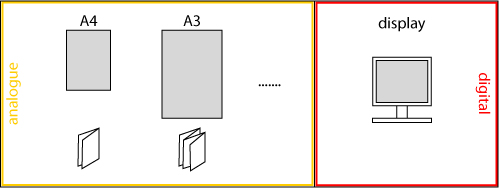 Display is always of the same size
Display is always of the same size
There are some methods to minimise the display problem:
| Switching on and off layers: Click on the checkboxes to switch on and off the layers. | Switching on and off layers |
| Tooltip: Move mouse courser over the rivers, cities and borders to see the information of the tooltip. | Tooltip |
| Zooming: Click on the buttons to zoom in and out. | Zooming in and out |
For Internet applications there exist another problem:
- Rate of Transmission:
An other problem occurs with internet applications because of big differences in transfer rates (analog modem: max. 56 to 64 kBit/s; DSL: max. 150 to 15000 Kbit/s).
Fastest download time for a 10 MB file with- Phone line: 24min 58s
- Broadband access (15MBit/s): 6s

The best option to avoid this problem is keeping the file sizes small.
Software Problems
- Browser Compatibility:
Not all users use the same browser software. This may cause problems,
because the presentation of HTML, etc. differs from browser to browser. The
reasons for this difference are listed in the box
"Browser War" below.
browser software. This may cause problems,
because the presentation of HTML, etc. differs from browser to browser. The
reasons for this difference are listed in the box
"Browser War" below.
In addition to the presentation, the capability of the different browsers varies as well (as you saw in the lesson Internet Techniques and Web Formats).
The presentation of a Web Page depends not only on the Web Browser software but also on the platform. A Web Page visualised in the Internet Explorer on a Windows computer looks different than in the Internet Explorer on a Macintosh (or Linux) as it is shown in the next images:
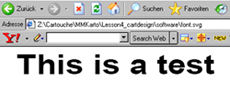 Font in Internet Explorer on Windows Font in Internet Explorer on Windows |
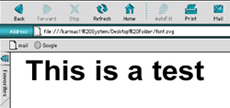 Font in Internet Explorer on Macintosh Font in Internet Explorer on Macintosh |
To solve the browser problem you have to test your application in different browsers and on different platforms. |
- Plugins:
Additionally, plugins can cause problems. Some formats such as Flash or PDF require a Plugin such as e.g. the Adobe Flash Player or Adobe Acrobat Reader. If the user has not installed the plugin, the content of the application will not be displayed: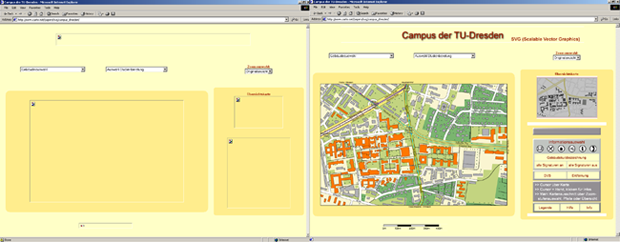 The visualisation of an application in a browser without the needed
plugin and with the needed plugin (Berger 2002)
The visualisation of an application in a browser without the needed
plugin and with the needed plugin (Berger 2002)
To solve this problem you ought to give the user the possibility to download the plugin by specifying the download link.
Not all users have the rights to install software on the computer that is used to view the application. In addition you have to be aware that not all plugins run on all platforms.
Browser War (Click here for more information)

